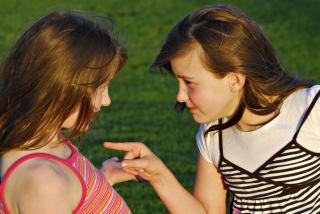Advertisement
Sibling rivalry is a tough issue to tackle. Goodness knows, I’m not the one to preach on this subject! My two kids behave like they are both the alpha eaglet, pecking at each other all day and night—probably with the very goal of eliminating the competition.
Most of my research on the subject while I was writing Tending the Flame: the Art of Unitarian Universalist Parentingpointed to the concept that sibling rivalry is rarely about the issue being squabbled about. It is actually a power struggle that manifests because children don’t feel comfortable asking directly for affection or affirmation when they need it.
This makes sense to me, as my two kids seem to get along just fine when I’m not around. But when I am, it’s a no-holds barred verbal wrestling match with plenty of trash talk. Other parents recognize that this pick-pick-picking at one another often takes a physical turn. As a child myself, I distinctly remember being bitten by my younger sister. When I complained to my mother, she told me to “bite her back.”
Perhaps not the best advice, even if the intention was to teach me how to resolve my own conflicts with my sister. However, it was also in conflict with another lesson I’d learned from my parents, which was that since I was the oldest, it was my job to protect and take care of my younger sister.
Now along comes fellow Unitarian Universalist parent and author Heather Shumaker with her book, It’s OK Not to Share and Other Renegade Rules for Raising Competent and Compassionate Kids(Tarcher/Penguin, 2012). Her “Ten Steps for Mediating Conflict with Kids” is comprehensive and highlights different strategies to use, including what to do when you witness a conflict but don’t catch the way it started. Shumaker suggests that kids need conflict because children “learn lifelong skills—including positive assertiveness, independence and mediation skills for managing future conflicts.”
I firmly believe that the home can be a training ground for teaching children the concepts of conflict mediation that they can then take out into the greater world, and Heather’s 10 Steps is a great resource toward making that a reality. Some of her other “renegade rules” are also just really great ideas—letting kids have plenty of free time just to play, for example, or recognizing that children who play with toy weapons are simply engaging in one more type of dramatic role-play. If we are able to step away from our own adult perspectives and biases, then we can start to understand that, for children, weapon play does not mean the same thing as it does to us. We need to be much more concerned about how kids act in real life than during playtime.
If we are able to help children learn peaceful ways to resolve real-life conflicts (like sibling rivalry) and ways to cope with their sometimes overwhelming emotions, then we can raise children who learn healthy responses to challenging conflicts.
